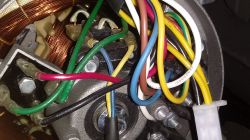boras_ptu wrote:A colleague has a self-excited generator without AVR, and here I would look for the cause.
Residual magnetism does not disappear by itself.
This is not true, the generators with AVR are also self-excited, and the AVR only regulates the voltage value. Residual magnetism, as colleague GFM wrote, depends on the magnetic properties of the rotor material. In this case, neodymium is added to strengthen this magnetism. This is the case with my aggregate, to which, after a little modification, you can add AVR.
Rotor photo, which was included in col. smerdendes in his post, it is from the generator with AVR and you can also see a magnet (probably neodymium) on it. The description of the problem suggests that there is not enough residual magnetism to excite. The description shows that after excitation of the generator from a foreign source, after stopping the generator, the magnetism quickly weakens. But I also do not exclude the fact that the reason may lie in the AVR itself, that it causes a break in the excitation circuit during a longer standstill, which should not be in this state.



